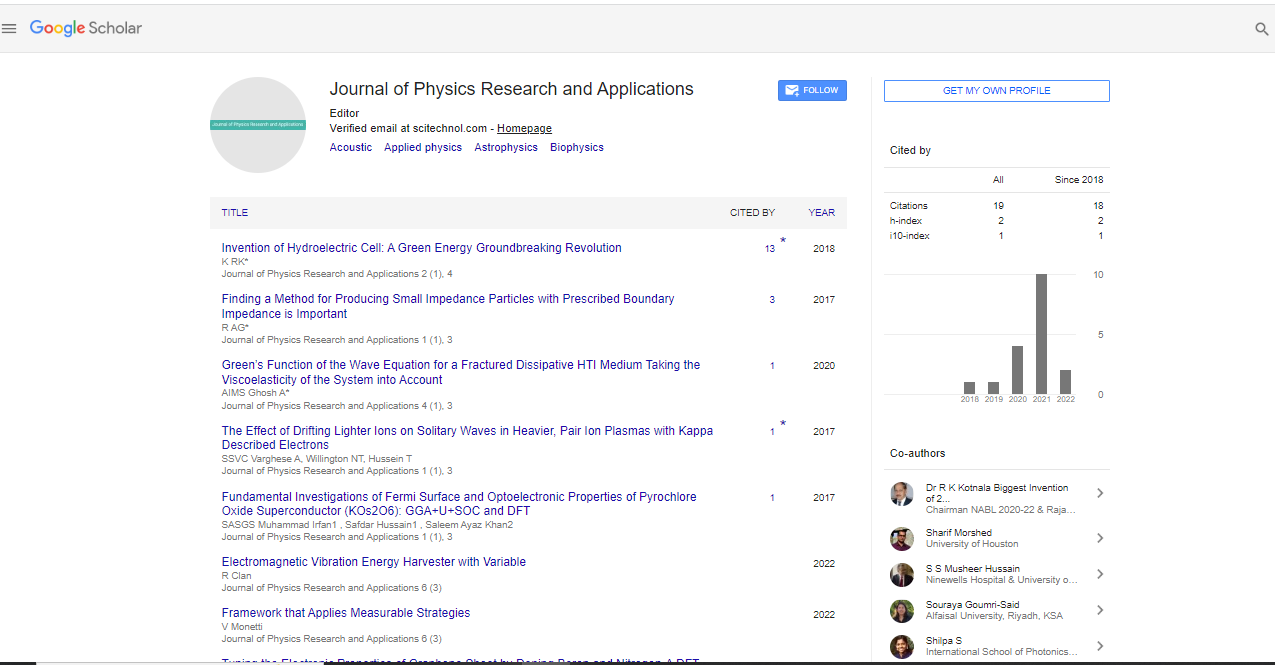Opinion Article, J Phys Res Appl Vol: 8 Issue: 3
Discoveries in Neutrino Physics and Mechanisms of Particle Mass Generation
Wang yu*
1Department of Physics, Donghua University, Shanghai, China
*Corresponding Author: Wang yu,
Department of Physics, Donghua University,
Shanghai, China
E-mail: wang@physics.cn
Received: 26 August, 2024, Manuscript No. JPRA-24-151995;
Editor assigned: 28 August, 2024, PreQC No. JPRA-24-151995 (PQ);
Reviewed: 11 September, 2024, QC No. JPRA-24-151995;
Revised: 18 September, 2024, Manuscript No. JPRA-24-151995 (R);
Published: 25 September, 2024, DOI: 10.4172/JPRA.1000119.
Citation: Yu w (2024) Discoveries in Neutrino Physics and Mechanisms of Particle Mass Generation. J Phys Res Appl 8:3.
Description
Neutrinos are among the most enigmatic particles in the universe. Despite being incredibly abundant, their elusive nature and tiny mass make them difficult to detect and understand. Neutrinos are elementary particles that belong to the lepton family, alongside electrons, muons, and tau particles. Neutrinos come in three types: Electron neutrinos, muon neutrinos and tau neutrinos, each associated with a corresponding charged lepton. One of the defining characteristics of neutrinos is their extremely small mass, significantly lighter than other particles, and their lack of electric charge, which allows them to interact with the weak nuclear force and gravity. Because of this weak interaction, neutrinos can pass through matter virtually unimpeded, making them challenging to detect. The Standard Model of particle physics originally assumed that neutrinos were massless, as no evidence of their mass had been observed and this assumption simplified the model.
One of the most important discoveries in neutrino physics is the phenomenon of neutrino oscillation, which implies that neutrinos have mass. Neutrino oscillation is the process by which a neutrino changes from one type to another as it propagates through space. The detection of neutrino oscillations led to a major outcome, because oscillations can only occur if neutrinos have mass. The discovery that neutrinos have mass has significant outcomes for our understanding of how mass is generated at the subatomic level. Within the Standard Model, particle masses are explained by the Higgs mechanism, wherein particles acquire mass through interactions with the Higgs field. However, the Higgs mechanism does not explain the origin of neutrino masses, as the Standard Model cannot account for their smallness without introducing new mechanisms or particles. One theoretical approach to understanding neutrino mass is the seesaw mechanism. This mechanism postulates the existence of a new, heavier type of neutrino, known as the right-handed neutrino, which interacts with left-handed neutrinos (the ones that participate in weak interactions) and creates a large mass disparity. The seesaw mechanism implies that the light neutrinos observed in experiments are light because of their interaction with these hypothetical heavy neutrinos.
Another implication of neutrino mass is its potential connection to physics beyond the Standard Model, particularly in theories like super symmetry and Grand Unified Theories (GUTs). These theories aim to unify the fundamental forces of nature and often predict the existence of particles and interactions that could account for neutrino mass. For example, GUTs propose that at extremely high energies, the fundamental forces (strong, weak, and electromagnetic) were unified and neutrino mass could be a remnant of this unification.
While neutrino oscillation experiments provide information about the differences in neutrino masses, they do not reveal the absolute masses of individual neutrino types. Determining the absolute mass scale of neutrinos remains an important goal in modern physics. Experimental approaches, such as tritium beta decay measurements, seek to measure neutrino mass directly. The Karlsruhe Tritium Neutrino Experiment (KATRIN) is one of the most precise efforts to measure the mass of neutrinos by examining the energy spectrum of electrons emitted in tritium decay.
Additionally, cosmological observations offer indirect ways to estimate neutrino masses. Since neutrinos were produced in abundance in the early universe, they affect the formation of largescale structures and the cosmic microwave background. Observations from telescopes like the Planck satellite, combined with theoretical models, help place constraints on the sum of neutrino masses, contributing to our understanding of their role in cosmic evolution.
 Spanish
Spanish  Chinese
Chinese  Russian
Russian  German
German  French
French  Japanese
Japanese  Portuguese
Portuguese  Hindi
Hindi 
